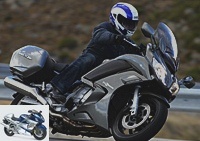Yamaha FJR 1300 A test: better and better !

Faced with increasingly fierce competition, Yamaha had to develop its best-seller GT, the FJR 1300. Invited to the presentation of this novelty in Spain, Site was able to take stock of the 2013 FJR 1300 A. First try.
Many improvements
Flagship of the brand with three tuning forks in the GT motorcycle segment (95,000 units sold worldwide since its launch in 2001), the FJR 1300 has made significant progress in 2013. It was high time, because the competition (BMW K1600 GT, Kawasaki GTR 1400, Triumph Trophy 1200 SE, etc.) tirelessly grows its weapons and constantly nibbles market share, those of the FJR 1300 steadily decreasing.
The 2013 vintages of the FJR 1300 A (manual gearbox) and AS (robotic gearbox) therefore benefit from numerous improvements, both aesthetic and functional as well as structural (read). Overall, the Japanese engineers set themselves the goal of optimizing the power-to-weight ratio, improving low-end torque and the functionality of the FJR 1300, without compromising its achievements..
The main contributions consist of the adoption of the YCC-T system (electronic throttle release management), Yamaha traction control (TCS) which increases safety by preventing the rear wheel from slipping, and the D-Mode system. which makes it possible to adapt the engine output according to the desired driving style ("T" for Touring, "S" for Sport). We also note the appearance of a cruise control operating between 3rd and 5th gear, which is very practical on motorways and expressways to calmly adjust to the maximum authorized speed. The internal fork components are improved, as are the rear shock settings, reworked to optimize comfort.
The front end of the FJR 1300 significantly evolves with a redesigned fairing and windshield to improve aerodynamics and wind protection. The air circuit is modified, now reducing turbulence and the suction phenomenon experienced by the driver on the previous model, while improving internal cooling. It is also possible to adjust the position of the two side covers without tools to further deflect the air flow passing through the legs.
Another notable improvement, also criticized on the old FJR 1300: the speed of the electric windshield height adjustment is shortened (twice as fast with a lightweight mechanism of 900 g!) And the chosen position retained after use (formerly , it was necessary to redo the adjustment after each ignition switch off). The dual-optic headlight is more aggressive and modern, incorporating diode position lights. Elements also chosen for the indicators.
The engine benefits for its part from many optimizations and gains 2 kW of maximum power, thanks to its new electronic management systems, the adoption of cylinders without jacket (as on the sports YZF 600 R6 and 1000 R1), new bodies of butterflies and a new exhaust. The number of catalysts in the exhaust system is reduced from four to two, reducing the emission of pollutant emissions..
Finally, the balancing on the central is done more easily and would require "30% less effort", according to Yamaha calculations. Ready? On the way !
Related articles
-
Road – Test Yamaha FJR1300 AS 2013: electronic facelift – Technical update Yamaha FJR 1300 AS 2013
Yamaha FJR1300 AS 2013 test: electronic facelift By equipping the FJR1300AS with the latest technological refinements, Yamaha has achieved a double blow:…
-
Road – Test Yamaha FJR 1300 A: better and better! – A versatile engine
Yamaha FJR 1300 A test: better and better ! Faced with increasingly fierce competition, Yamaha had to develop its best-seller GT, the FJR 1300. Invited…
-
Road – Test Yamaha FJR1300 AS 2013: electronic facelift – A motorcycle à la carte
Yamaha FJR1300 AS 2013 test: electronic facelift By equipping the FJR1300AS with the latest technological refinements, Yamaha has achieved a double blow:…
-
Road – Test Yamaha FJR 1300 A: better and better! – Assessment: almost the same … only better!
Yamaha FJR 1300 A test: better and better ! Faced with increasingly fierce competition, Yamaha had to develop its best-seller GT, the FJR 1300. Invited…
-
Road – Test Yamaha FJR1300 AE: on the right gear – Rich but also manageable
Yamaha FJR1300 AE test: on the right gear Flagship of the Yamaha GT range, the FJR 1300 evolves smoothly for 2016, with the obligatory change to Euro 4,…
-
Yamaha FJR 1300 Tourer in the test
Yamaha FJR 1300 in the test Tourer shows remarkable performance in the top test With its mix of remarkable performance and solid long-distance comfort,…
-
Road – Test Yamaha FJR 1300 A: better and better! – Video Yamaha 1300 FJR 2013
Yamaha FJR 1300 A test: better and better ! Faced with increasingly fierce competition, Yamaha had to develop its best-seller GT, the FJR 1300. Invited…
-
Road – Test Yamaha FJR 1300 A: better and better! – Heavy but very opulent
Yamaha FJR 1300 A test: better and better ! Faced with increasingly fierce competition, Yamaha had to develop its best-seller GT, the FJR 1300. Invited…
-
Big bikes test comparison: Honda CBR 1100 XX Super Blackbird, Kawasaki Ninja ZX-12R , Suzuki GSX 1300 R Hayabusa , Yamaha FJR 1300 A Two fast, two…
-
Comparison test Harley-Davidson Sportster 1200 Custom against Yamaha XVS 1300 A Midnight Star
Comparison test Harley-Davidson Sportster 1200 Custom against Yamaha XVS 1300 A Midnight Star Through thick and thin Would you rather drive a fat Japan…